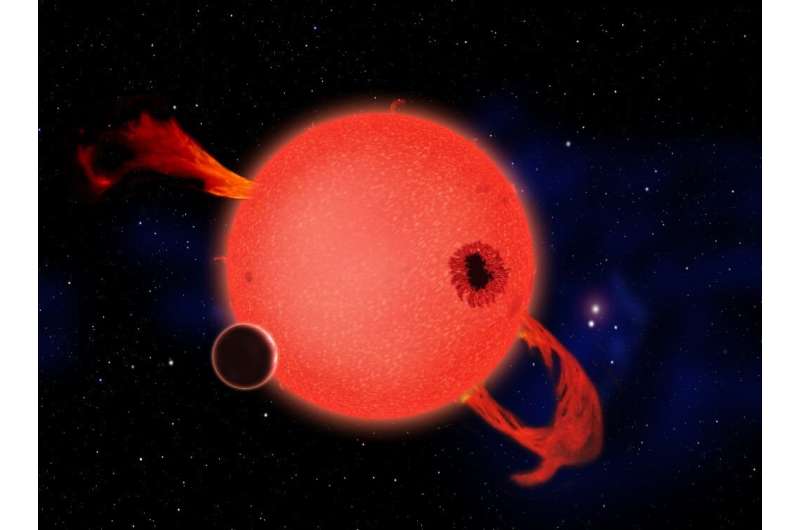This article has been reviewed according to Science X's editorial process and policies. Editors have highlighted the following attributes while ensuring the content's credibility:
fact-checked
preprint
trusted source
proofread
Astronomers find a 'red nova': A main-sequence star just eating its planet

Back in 2020 astronomers observed a red nova, which while enormously powerful, is on the low side of energetic events in the universe. Now an astronomer has studied the event in close detail and has come to the conclusion that we have just witnessed a star destroying its own planet.
The technical jargon term for these red nova events are "intermediate luminosity optical transits," or ILOTs. These are extremely rare events to observe, because they only produce a moderate amount of energy. That makes it hard for us to capture them in observations. But despite the rarity of the events, astronomers suspect that they occur very frequently throughout the universe.
For years astronomers have wondered if these red novas were caused by planets being engulfed by their parent stars. Several ILOT candidates have been closely examined with this scenario in mind, but astronomers have found it difficult to match up theoretical predictions of this scenario with the actual observational results.
But this new observation, known as ZTF SLRN-2020, may just fit the bill. Previous cases of suspected star-planet interactions happen in very young systems, where planets are on chaotic trajectories, colliding into each other and occasionally diving headfirst into their stars. But in this case the star is on the main sequence, meaning that it is a normal middle-aged star. The research is published on the arXiv preprint server.
The astronomer behind the study concluded based on theoretical calculations that however this planet ended up getting close to its star, it was not a simple matter of the planet slipping into the atmosphere of the star and calling it a day. Instead it went through several violent phases as the planet was torn apart and the red nova flared.
As the planet neared the star it heated up, with its outer layers turning into a plasma. Complex flows of electricity and magnetism caused this plasma to launch a pair of jets away from the planet as it was orbiting the star. However, those jets were not powerful enough to escape from the gravitational influence of the star completely, and so that material rained back down.
But even though the planet reacquired some of its mass lost in the form of the jets, the planet lost it again due to the intense energies near the surface of the star. Before complete engulfment, the planet might have formed an accretion disk around the star itself. Material from the destroyed planet slowly leaked and funneled into the star before it was all finally over. However, the accretion disk itself would be capable of launching its own jets which could punch away from the star, expanding and nebula away from the system.
Needless to say, the interaction between the planet and the star over the course of its engulfment released an incredible amount of energy resulting in the red nova. We still do not know the details of the system or how this planet came to be so unlucky. Astronomers hope to find even more of these lower energy transient events to help us understand the complex relationships between planets and their parent stars.
More information: Noam Soker, On the nature of the planet-powered transient event ZTF SLRN-2020, arXiv (2023). DOI: 10.48550/arxiv.2305.04909
Journal information: arXiv
Provided by Universe Today





















